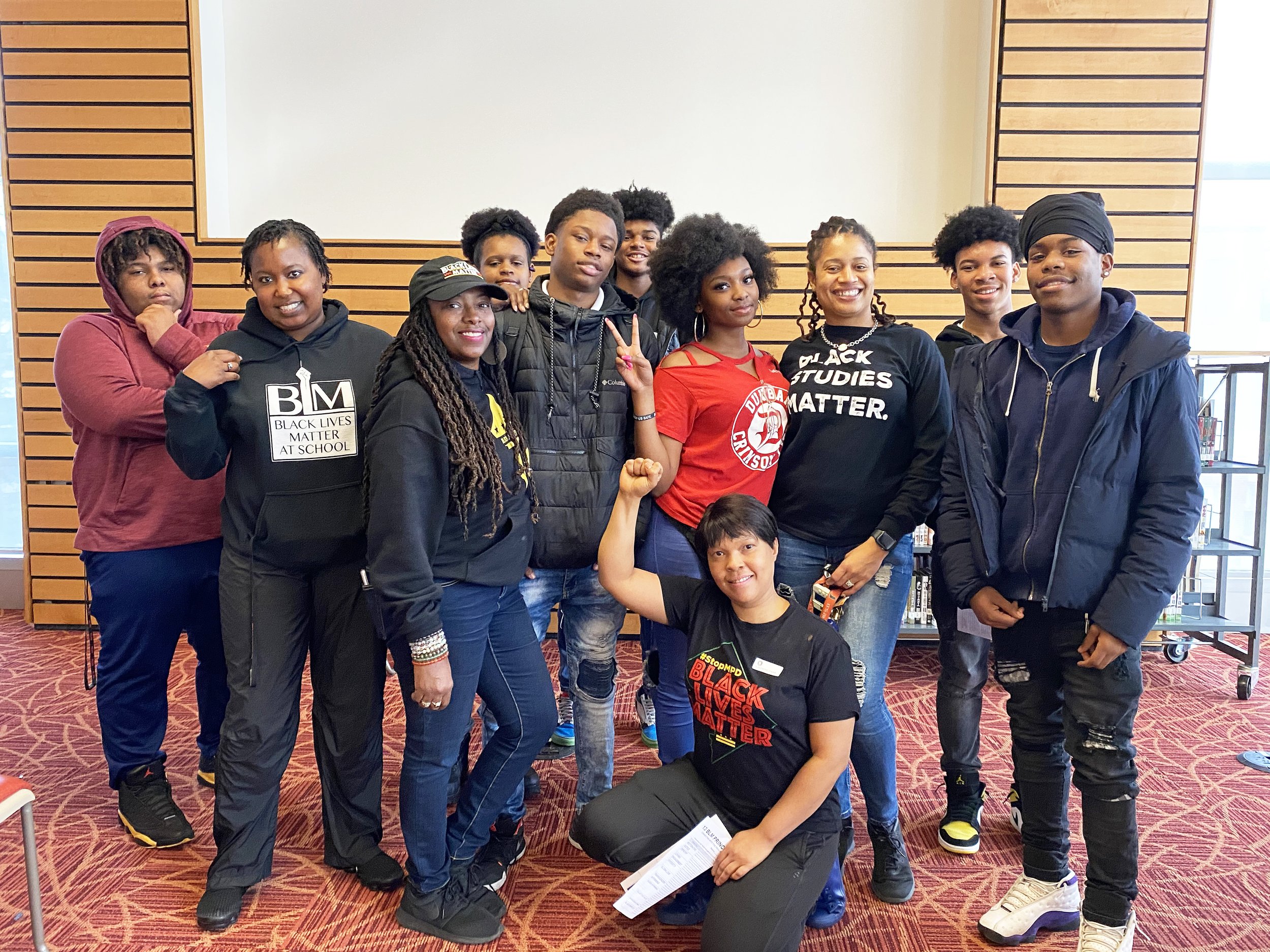Seven Things We Learned from the D.C. Area Black Lives Matter at School Week of Action
Reading by Allison Fletcher Acosta, Fayette Colon, and Deborah Menkart
Students at Dunbar Senior HS (DCPS) with Black Lives Matter DMV organizers. Photo by Rosalie Reyes.
Since 2018, the Black Lives Matter at School Week of Action has given a powerful start to Black History Month in classrooms across the country. Pre-K to 12th-grade teachers teach lessons about structural racism, intersectional Black identities, and Black history.
The key demands issued by the Black Lives Matter at School national movement are:
End “zero tolerance” discipline and implement restorative justice.
Hire more Black teachers.
Mandate Black history and ethnic studies in K–12 curriculum.
Fund counselors, not cops.
The Washington, D.C. metro area is one of many sites across the country that participates annually in the national Black Lives Matter Week of Action. This site is coordinated by D.C. Area Educators for Social Justice, a project of Teaching for Change.
Below, we share what we have learned from hosting the D.C. Area Black Lives Matter at School Week of Action. Short examples of what teachers have done in the classroom during the Week of Action are woven throughout this article. You can find more than 200 teaching stories at DCAreaEducators4SocialJustice.org.
1.) A Movement brings radical change to the classroom.
In many schools, the week of action opens a dialogue that leads to deeper understanding of the 13 principles of the Black Lives Matter Movement. Applying the lens of the 13 principles sharpens the focus of Black History Month. Going beyond the “I have a dream” lessons on the Civil Rights Movement, students have learned about Bayard Rustin, the Student Nonviolent Coordinating Committee (SNCC), Black Power, Dr. Martin Luther King’s stand on the war and labor, and much more. A 2nd grader remarked, “Black Lives Matter is like the Civil Rights Movement.”
2.) The Black Lives Matter Movement helps students connect with history in a new way.
The week of action invites students to reflect on the long history of the Black Freedom Struggle. For example, a 6th-grade Arlington teacher began her lesson on the U.S. Constitution with a discussion of the Black Lives Matter Movement. The class read Mumbet’s Declaration of Independence, the true story of an enslaved woman in Massachusetts who sued for her own freedom. After the read aloud, students read the preamble to the Constitution and discussed who wasn’t included in the “we the people” phrase. Bringing it to today, they brainstormed how they could use the Constitution to fight for justice on issues in their own lives such as sexual harassment, deportation, the Muslim ban, healthcare, police brutality, and voting rights. In a 1st-grade classroom, students learned about bias in museums and how to curate their own history using a book called Milo’s Museum.
First grade students at Inspired Teaching Demonstration PCS created artwork after reading Zetta Elliott’s Milo’s Museum. Photo by Allison Fletcher Acosta.
3. Black Lives Matter is relevant to all grade levels.
During the week of action, the principles of the Black Lives Matter Movement are introduced in developmentally appropriate ways from early childhood through high school.
One D.C. early childhood teacher designed a two-week curriculum that covered each of the 13 guiding principles. The class read a book (or two) each day that addressed one of the principles, with the principles of empathy, diversity, and unapologetically Black reinforced daily.
An elementary teacher designed an activism unit for the Week of Action. Students learned about activists in history and today, young and old, including Marley Dias and her #1000BlackGirlBooks campaign; Mari Copney, “Little Miss Flint”; Colin Kaepernick; and Barbara Jordan. They also learned about types of activism, such as boycotts, sit-ins, strikes, writing letters, and political activism.
At one D.C. school, the community created a Black Lives Matter mural. The youngest learners contributed what is beautiful and Black. Elementary students added a panel of what it takes to be alive, and middle school students expressed why the Black Lives Matter movement is important. One 8th grader reacted, “It means a whole lot that our school is honoring Black lives because I like to fight for justice.”


